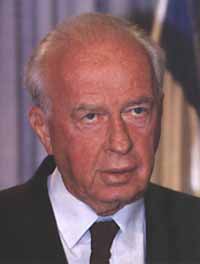Condolence Page and Biography of Israeli Prime Minister Yitzhak Rabin

YITZHAK RABIN
Prime Minister of Israel
1922 - 1995
Click here to read "The Song For Peace".

YITZHAK RABIN
Prime Minister of Israel
1922 - 1995
Click here to read "The Song For Peace".
You can view the Condolence Books by pressing here.
 Click here to light a candle.
Click here to light a candle.
|
 Click here to hear Rabin memorial speeches. |
Click here to see photographs of Yitzhak Rabin.
P
rime Minister Yitzhak Rabin was born in Jerusalem on March 1 1922. His
father Nehemieh had immigrated to Israel from the United States and
in World War 1 served as a volunteer in the Jewish Legion.
His mother, Rosa, was one of the first members of the Haganah.
Yitzhak Rabin attended primary school in Tel-Aviv, and the Kedoorie
agricultural college in the Lower Galilee, from which he graduated
with distinction.
After completing his schooling, he volunteered for the Palmach,
where he began his military career. He served in the Palmach and
the Israel Defence Forces for 27 years. In 1949 he was a member of
the Israeli delegation for the first negotiations with Egypt.
On January 1st 1968, he retired from service in the IDF, where he
had served as Chief of Staff. Shortly afterwards, he was appointed
Israeli Ambassador to Washington, and on March 5th 1968 presented
his Letter of Credential to the President of the United States.
During his years of service, as Ambassador to Washington, he
consolidated and cultivated the ties between the two states.
In Spring 1973, he returned to Israel's capital, Jerusalem, and
became active in the Israel Labor party. In the December 1973
elections he was elected to the Knesset (Israeli Parlament), and
when Golda Meir formed her Government in April 1974, he was
appointed Minister of Labor.
On June 2nd 1974, the Knesset expressed confidence in a new
government headed by Yitzhak Rabin.
Yitzhak Rabin served as Prime Minister of Israel following the Yom
Kippur War. During this period, special emphasis was placed on
improving the economy, solving economic and social problems, and
strengthening the IDF. With American mediation, Rabin conducted
negotiations on the interim agreement with Egypt, signed in 1975.
As a result of this agreement, the first memorandum of
understanding was signed between the governments of Israel and the
United States.
In June 1976, the government headed by Rabin, ordered the Entebbe
operation.
Following the May 1977 elections, Rabin served as a labor member of the
Knesset in opposition, and was a member of the Foreign Affairs and
Defence Committee. He filled these positions until the formation of
a national unity government in September 1984.
Rabin served as Minister of Defence in the national unity
government from September 1984 until March 1990.
In January 1985, he presented to the government the proposal for
the IDF withdrawal from Lebanon and the establishment of a
security zone guaranteeing peace to the settlements along Israel's
Northern border.
In May 1989, the government of Israel adopted his plan for an
arrangement with the Palestinians, in stages, which has served as
the basis for the recent peace making efforts.
From March 15th 1990 he was a member of Knesset in opposition.
Yitzhak Rabin was elected chairman of the Israel Labor party in
it's first nation wide primaries conducted in February 1992.
Following the June 1992 elections, Yitzhak Rabin was elected to
head the current Israeli government.
His premiership was marked by the following landmarks in the peace process:
On September 13, 1993, at the signing of the Israeli-Palestinian Declaration of
Principles on the White House lawn, Prime Minister Rabin shook hands with
PLO Chairman Yasser Arafat.
On October 26, 1994, on the Israel-Jordan border, he signed the Treaty of Peace
between the State of Israel and the Hashemite Kingdom of Jordan.
On September 28, 1995, he was a signatory to the Israeli-Palestinian Interim
Agreement on the West Bank and the Gaza Strip.
Rabin was awarded the Nobel Prize for Peace in December 1994, along with Foreign
Minister Shimon Peres and PLO Chairman Yasser Arafat.
A biography of Yitzhak Rabin, "Service Notebook", was published in
1979, and was translated into English and French.
His book on Lebanon, written after the Operation Peace for Galilee,
was published in 1983.
Prime Minister Yitzhak Rabin was assassinated on November 4th
1995, while attending a peace rally in Tel-Aviv.
Yitzhak Rabin leaves his wife Leah, his daughter Dalia, his son
Yuval and three grandchildren.
The funeral took place on Monday, November 6th, at 2:00 p.m. in Jerusalem.
When the late Prime Minister was laid to rest, air raid sirens sounded
for two minutes throughout the entire country.
Among the world leaders who attended the funeral were President Clinton,
King Hussein of Jordan and Egyptian President Hosni Mubarak.
The Israeli Cabinet decided that flags at state institutions and IDF bases will be
lowered to half-mast.
The mood in Israel was very somber with black ribbons hanging from office
buildings and streaming from car antennas.
This Page, which was created four hours after the assassination, has been
visited by over 100,000 people.
"We should not let the land flowing with milk and honey, become
the land flowing with blood and tears." [Yitzhak Rabin]
We thank the Israeli Government Press Office for providing much of the above information.
